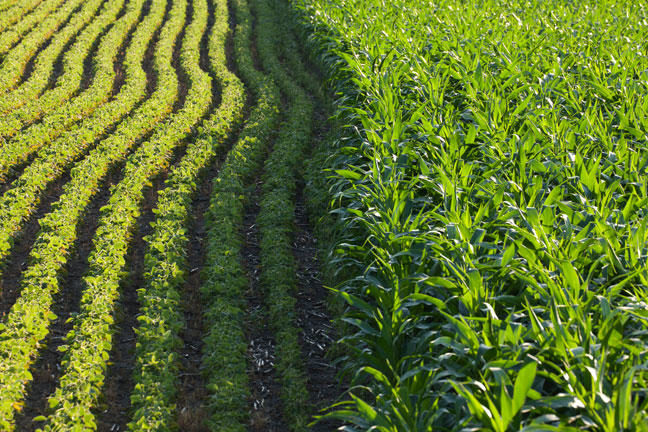A new study from researchers at the University of Minnesota and Iowa State University finds that diversifying crop rotations can greatly reduce negative environmental and health impacts, while maintaining profitability for farmers.
The research, recently published in the journal Environmental Science and Technology, finds that adding small grains and forages such as alfalfa to the conventional corn-soybean rotation, which dominates production in Minnesota, Iowa and other Corn Belt states, can greatly reduce negative environmental impacts while supporting farm economies.
“Farmers have long practiced crop rotation to maintain the productivity of their land,” said Natalie Hunt, teaching assistant professor in the Department of Bioproducts and Biosystems Engineering in the U of M’s College of Food, Agricultural and Natural Resource Sciences and College of Science and Engineering. “We show that adding more crops to the conventional corn-soy rotation is beneficial to both farmers and the environment.”
The work was based on data from a large-scale, long-term field experiment at Iowa State University's Marsden Farm. The experiment, initiated in 2001, compares the performance characteristics of a two-year corn-soy rotation with those of a three-year corn-soybean-oat rotation and a four-year corn-soybean-oat-alfalfa rotation.
“This new paper adds important insights into the environmental impacts and human health consequences of conventional and more diverse cropping systems,” said Matt Liebman, professor of Agronomy and the H.A. Wallace Endowed Chair for Sustainable Agriculture at Iowa State University. "This type of information is important for developing sustainable and resilient ways to farm while protecting the planet."
The researchers looked at pollution from farming as well as from the supply chain, including the production of fertilizers, fuel and herbicides. They combined field experiment data with emissions datasets and an air quality model, to estimate emissions and damages from climate change, human health via pollution and the amount of fossil fuels associated with each cropping system.
They found the major driver of fine particle matter emissions is application of manure and application and storage of fertilizer, which requires a great deal of fossil fuel to produce. Furthermore, when fertilizer is applied to crops, it releases greenhouse gases and pollutants that harm air quality, mainly ammonia. Other contributors of fine particle matter are diesel fuel production, herbicide production, dust from field operations and fossil fuel combustion by farm machinery. By adding small grains and forages into rotations, less fertilizer is required and less pollution is emitted due to increased per-hectare corn and soybean productivity, greater resilience to weed and pest infestations, and reduced dependence on synthetic herbicides. Diversified cropping systems can also have reduced rates of soil erosion and nutrient discharge to the environment, lower freshwater toxicity loads and enhanced soil functioning.
The addition of a single small grain crop can reduce fossil fuel use, pollution and damages by about one-half, according to the research. The study also found more diverse rotation systems:
-
used 56% less fossil fuels;
-
generated 54% fewer greenhouse gas emissions;
-
and had monetized damages from greenhouse gas emissions and air pollutants 42% lower than the conventional corn-soybean system.
“Reintegrating farming practices from just a few generations ago has the potential to yield positive environmental benefits," Hunt said.
More than 30 scientific papers published from work at the Marsden Farm site have addressed crop yields, soil properties, weeds, economic costs and returns, ecological processes and other subjects. In previous work, the researchers showed that diversifying crops could reduce soil erosion and nutrient discharge loss. This study extends their previous findings to include pollution in the air.
”The Midwest agricultural landscape became much less diverse after World War II as synthetic fertilizers and pesticides became more widely used, and as livestock production was largely decoupled from crop production” Liebman said. “Our work shows that returning to more diverse crop rotations can be a win-win-win for farmers, the public and the environment.”
Financial support for the study came from the U.S. Department of Agriculture, the Leopold Center for Sustainable Agriculture, and the U.S. Environmental Protection Agency.






